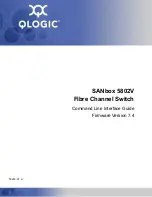
1-3
Table 1-2
Description of the fields in a SNAP-encapsulated LLDP frame
Field
Description
Destination MAC address
The MAC address to which the LLDPDU is advertised. It is fixed
to 0x0180-C200-000E, a multicast MAC address.
Source MAC address
The MAC address of the sending port. If the port does not have
a MAC address, the MAC address of the sending bridge is
used.
Type
The SNAP type for the upper layer protocol. It is
0xAAAA-0300-0000-88CC for LLDP.
Data LLDPDU.
FCS
Frame check sequence, a 32-bit CRC value used to determine
the validity of the received Ethernet frame.
LLDPDUs
LLDP uses LLDPDUs to exchange information. An LLDPDU comprises multiple type, length, and value
(TLV) sequences, each carrying a type of device information, as shown in
Figure 1-3
.
Figure 1-3
An LLDPDU
An LLDPDU can carry up to 28 types of TLVs, of which the chassis ID TLV, port ID TLV, TTL TLV, and
end of LLDPDU TLV (end TLV in the figure) are mandatory TLVs that must be carried and other TLVs
are optional.
TLVs
TLVs are type, length, and value sequences that carry information elements, where the type field
identifies the type of information, the length field indicates the length of the information field in octets,
and the value field contains the information itself.
LLDPDU TLVs fall into these categories: basic management TLVs, organizationally (IEEE 802.1 and
IEEE 802.3) specific TLVs, and LLDP-MED (media endpoint discovery) TLVs. Basic management TLVs
are essential to device management. Organizationally specific TLVs and LLDP-MED TLVs are used for
enhanced device management; they are defined by standardization or other organizations and thus are
optional to LLDPDUs.
1) Basic management TLVs
Table 1-1
lists the basic management TLV types currently in use. Some of them are mandatory to
LLDPDUs, that is, must be included in every LLDPDU.
















































